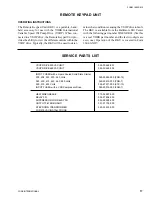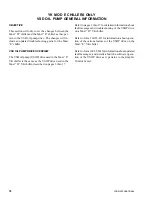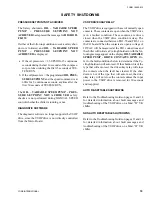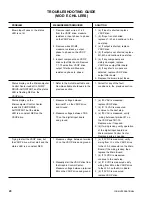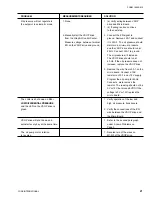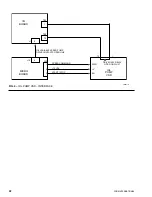
YORK INTERNATIONAL
16
MOST FREQUENTLY ASKED QUESTIONS
1. Why doesn’t the rotation of the motor change
when I change the input wiring to the VSOP
drive?
The VSOP drive converts the input line into a DC
bus voltage then converts the DC bus voltage back
into an AC voltage with a varying frequency. So,
the output section of the drive isolates the output
from the input of the drive.
2. How is oil pressure regulated?
A differential oil pressure setpoint is programmed
through the Microcomputer Control Center. This
setpoint is then used to regulate the oil pressure.
The speed of the oil pump motor will increase if
the oil pressure is less than the setpoint by 0.5 PSID.
Also, the speed of the oil pump motor will decrease
if the oil pressure is greater than the setpoint by 0.5
PSID.
3. On a 50 Hz installation, how can the VSOP
drive still run at 60 Hz?
Normal operation of a motor requires that the in-
crease in frequency and the increase in voltage
occur at the same rate. This is called linear volts/
Hz curve. If the supply voltage for 50 Hz is the
same as 60 Hz, then the drive can develop enough
voltage to supply a 60 Hz motor. The gating of the
output power devices determines the output fre-
quency, not the input frequency to the VSOP drive.
4. What are the differences between the Solid
State Starter (SSS) and a VSOP drive?
The SSS reduces the amplitude of the voltage ap-
plied to the motor during start-up, by gradually turn-
ing on SCR’s connected to the input line. Inrush
current is reduced since the voltage applied to the
motor is reduced. This method of controlling a
motor has no effect on the frequency of the volt-
age. When full voltage is applied to the motor the
SCR’s are fully turned on. The VSOP drive is the
same as a Variable Speed Drive. This type of drive
employs an input stage, an energy storage stage,
and an output stage. The input stage converts the
AC input into a DC supply by rectifying the input
line voltage. The DC supply is stored in the energy
storage stage. The energy is stored in a capacitor
bank. The stored energy is then converted into a
varying voltage and frequency in the output stage.
The output stage uses very fast switches that switch
with a constant frequency (of about 6 KHz) but
with a varying duty cycle. The varying duty cycle
allows the output to vary in frequency and voltage.
5. Can the VSOP drive be bypassed and run the
oil pump motor directly across the line?
Yes, but the oil pressure will not be regulated. The
chiller will shutdown on high oil pressure. This should
be done to troubleshoot the motor or the VSOP
drive only.
6. Can I read the VSOP output frequency with a
hand-held meter?
Yes, but the meter reading will not be correct. The
output frequency of the VSOP drive is actually
several KHz. This frequency is what is called the
carrier frequency. The motor acts like a filter to
the carrier frequency and the fundamental fre-
quency, or 60 Hz, is what is left. The hand-held
meter will detect the carrier frequency, but not the
fundamental frequency.
















